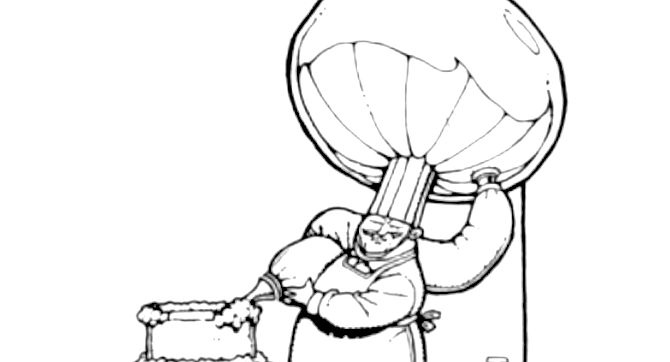 Facebook
Facebook
 X
X
 Instagram
Instagram
 TikTok
TikTok
 Youtube
Youtube

Dear Man hew Alice: What is the origin of the tall, puffy hat traditionally worn by chefs? We expect it has some mysterious purpose since a simple hair net would adequately protect hair from falling into the food. — Larry and Naomi, Mission Hills
If, indeed, form follows function, the traditional chefs hat (called a toque) certainly is a mystery. Hard enough to whip up a successful beef Wellington without balancing a 12-inch, starched, cotton tube on your head. In fact, peek into virtually any restaurant kitchen these days, and you’ll probably see the workers wearing hair nets or small white paper hats or even baseball caps. The toque is, for the most part, relegated to public appearances, a professional symbol, not a practical piece of headgear.
Today’s restaurant kitchen reflects the innovations of France’s chef de chefs George-Auguste Escoffier (1846-1935). He hooked up with the equally brilliant hotelier Osar Ritz and changed the dining-out experience for all time. Among other things, Escoffier revamped the whole manner of food presentation, from the so-called English service to Russian service. In the English style, all the dishes for the meal are placed on the table at one time (as many as 30 or 40 for a big, fancy dinner in those days); Russian service presents each course separately, served either from a sideboard or directly from the kitchen. Seven or eight courses was the norm back then, all carefully designed and choreographed for maximum drama by the chef himself.
Behind the scenes, too, Escoffier exercised his dictatorial powers, turning the restaurant kitchen from bedlam to military order. He devised the now-standard system of an executive chef directing a platoon of under-chefs, each with his own expertise—baking, sauce preparation, and so on. In the typical European restaurant kitchen of the 1800s, the cooks wore short white stocking caps or slightly oversized berets. To distinguish the new post of kitchen dictator, Escoffier himself wore a pneumatic version of the traditional cap, with a stiff band several inches high and a soft crown poofed like a souffle. In fact, the new post of kitchen czar was referred to as the gros bonnet, the big hat. The diminutive Escoffier had to wear platform shoes when working in the kitchen, so perhaps the gros bonnet idea was another way of literally increasing his stature.
Today’s hyperinflated toque is supposed to represent the chef s level of expertise. The higher the hat, the smarter the cook. Or the bigger the ego, anyway. Traditional toques have 100 tiny pleats, symbolic, it’s said, of either the number of ways a brilliant chef can prepare an egg or the number of days of mourning observed following Escoffier’s death.


Dear Man hew Alice: What is the origin of the tall, puffy hat traditionally worn by chefs? We expect it has some mysterious purpose since a simple hair net would adequately protect hair from falling into the food. — Larry and Naomi, Mission Hills
If, indeed, form follows function, the traditional chefs hat (called a toque) certainly is a mystery. Hard enough to whip up a successful beef Wellington without balancing a 12-inch, starched, cotton tube on your head. In fact, peek into virtually any restaurant kitchen these days, and you’ll probably see the workers wearing hair nets or small white paper hats or even baseball caps. The toque is, for the most part, relegated to public appearances, a professional symbol, not a practical piece of headgear.
Today’s restaurant kitchen reflects the innovations of France’s chef de chefs George-Auguste Escoffier (1846-1935). He hooked up with the equally brilliant hotelier Osar Ritz and changed the dining-out experience for all time. Among other things, Escoffier revamped the whole manner of food presentation, from the so-called English service to Russian service. In the English style, all the dishes for the meal are placed on the table at one time (as many as 30 or 40 for a big, fancy dinner in those days); Russian service presents each course separately, served either from a sideboard or directly from the kitchen. Seven or eight courses was the norm back then, all carefully designed and choreographed for maximum drama by the chef himself.
Behind the scenes, too, Escoffier exercised his dictatorial powers, turning the restaurant kitchen from bedlam to military order. He devised the now-standard system of an executive chef directing a platoon of under-chefs, each with his own expertise—baking, sauce preparation, and so on. In the typical European restaurant kitchen of the 1800s, the cooks wore short white stocking caps or slightly oversized berets. To distinguish the new post of kitchen dictator, Escoffier himself wore a pneumatic version of the traditional cap, with a stiff band several inches high and a soft crown poofed like a souffle. In fact, the new post of kitchen czar was referred to as the gros bonnet, the big hat. The diminutive Escoffier had to wear platform shoes when working in the kitchen, so perhaps the gros bonnet idea was another way of literally increasing his stature.
Today’s hyperinflated toque is supposed to represent the chef s level of expertise. The higher the hat, the smarter the cook. Or the bigger the ego, anyway. Traditional toques have 100 tiny pleats, symbolic, it’s said, of either the number of ways a brilliant chef can prepare an egg or the number of days of mourning observed following Escoffier’s death.
Comments